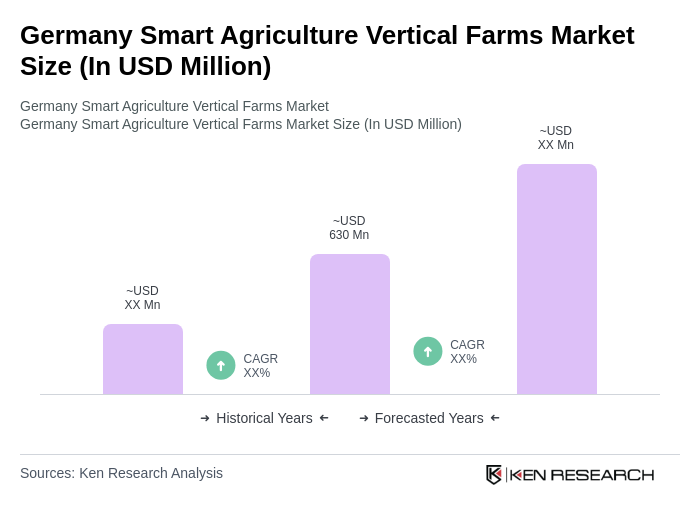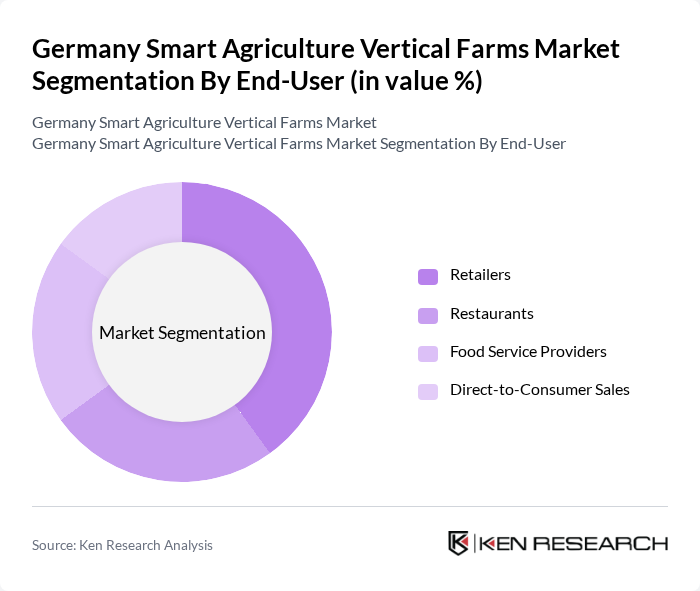Region:Europe
Author(s):Geetanshi
Product Code:KRAA3649
Pages:92
Published On:September 2025

By Type:The market is segmented into various types, including Hydroponics, Aeroponics, Aquaponics, Shipping Container Farms, Building-Based Vertical Farms, Greenhouses, and Others. Among these,Hydroponicsis the leading sub-segment due to its efficiency in water usage and ability to produce high yields in limited spaces. Hydroponic systems use up to 95% less water than conventional farming and enable year-round production, which is especially attractive in urban environments. The growing consumer preference for organic and pesticide-free produce has further boosted the adoption of hydroponic systems in urban areas .

By End-User:The end-user segmentation includes Retailers, Restaurants, Food Service Providers, and Direct-to-Consumer Sales.Retailersare the dominant segment, driven by the increasing demand for fresh produce in supermarkets and grocery stores. The trend towards health-conscious eating and the preference for locally sourced food have led retailers to invest in vertical farming solutions to meet consumer expectations. Supermarkets and institutional buyers are increasingly sourcing vertically farmed products to ensure consistent quality and traceability .

The Germany Smart Agriculture Vertical Farms Market is characterized by a dynamic mix of regional and international players. Leading participants such as Infarm, ECF Farmsystems, Farmers Cut, GrowUp Farms, Urban Crop Solutions, Greeny Garden, Agrilution, Vertical Future, Fraunhofer Institute for Molecular Biology and Applied Ecology IME, Aponix GmbH, Greenhub Solutions, Plantagon, Sky Greens, AeroFarms, and Plenty contribute to innovation, geographic expansion, and service delivery in this space.
As urbanization continues to rise and sustainability becomes a priority, the future of vertical farming in Germany looks promising. The integration of advanced technologies will likely enhance operational efficiency, while government support for sustainable practices will further encourage investment. Additionally, consumer preferences are shifting towards locally sourced and organic produce, creating a favorable environment for vertical farms. The sector is expected to evolve, with more urban areas adopting vertical farming solutions to meet food demands sustainably and efficiently.
| Segment | Sub-Segments |
|---|---|
| By Type | Hydroponics Aeroponics Aquaponics Shipping Container Farms Building-Based Vertical Farms Greenhouses Others |
| By End-User | Retailers Restaurants Food Service Providers Direct-to-Consumer Sales |
| By Application | Leafy Greens Herbs Fruits Flowers |
| By Investment Source | Private Investments Government Grants Venture Capital Crowdfunding |
| By Distribution Channel | Online Sales Direct Sales Wholesale Retail Outlets |
| By Technology | LED Lighting Climate Control Systems Nutrient Delivery Systems Automation Technologies |
| By Policy Support | Tax Incentives Research and Development Grants Training Programs for Farmers Public Awareness Campaigns |
| Scope Item/Segment | Sample Size | Target Respondent Profiles |
|---|---|---|
| Vertical Farm Operators | 60 | Farm Managers, Technology Implementers |
| Agricultural Technology Providers | 50 | Product Development Managers, Sales Directors |
| Government Agricultural Agencies | 40 | Policy Makers, Program Coordinators |
| Research Institutions | 45 | Research Scientists, Academic Professors |
| Retailers of Fresh Produce | 55 | Supply Chain Managers, Procurement Officers |
The Germany Smart Agriculture Vertical Farms Market is valued at approximately USD 630 million, driven by urbanization, sustainable food production needs, and advancements in agricultural technology.